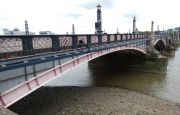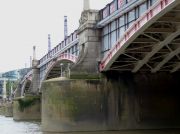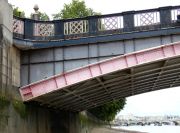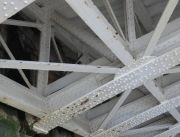Lambeth Bridge: Difference between revisions
No edit summary |
No edit summary |
||
| Line 20: | Line 20: | ||
The present structure, a five-span steel arch, designed by engineer Sir [[George W. Humphreys]] and architects Sir Reginald Blomfield and G. Topham Forrest, was built by [[Dorman, Long and Co]] and opened on 19 July 1932 by King George V. It formerly carried four lanes of road traffic (now reduced to three lanes). | The present structure, a five-span steel arch, designed by engineer Sir [[George W. Humphreys]] and architects Sir Reginald Blomfield and G. Topham Forrest, was built by [[Dorman, Long and Co]] and opened on 19 July 1932 by King George V. It formerly carried four lanes of road traffic (now reduced to three lanes). | ||
1932 'CHELTENHAM'S SHARE IN LAMBETH BRIDGE. Gloucestershire will have a particular interest m the new Lambeth Bridge which is being opened by the King on Tuesday. [[H. H. Martyn | 1932 'CHELTENHAM'S SHARE IN LAMBETH BRIDGE. Gloucestershire will have a particular interest m the new Lambeth Bridge which is being opened by the King on Tuesday. [[H. H. Martyn]] and Company, Limited, of Cheltenham, the famous architectural decorators, are responsible for much work on London’s latest bridge. They cast in their foundry at Cheltenham the magnificent gilt bronze pine-apple shaped finials which surmount the obelisks at the entrance to the bridge. Further, the eight carvings at the head of each pier are also the work of this firm. These carvings, which are sculptured out of granite blocks each weighing 21 tons, incorporate in their design the arms of the London County Council.'<ref>Gloucester Journal - Saturday 16 July 1932</ref> | ||
Revision as of 12:19, 5 July 2024







Lambeth Bridge is a road traffic and footbridge crossing the River Thames in an east-west direction in central London; the river flows north at the crossing point. Downstream, the next bridge is Westminster Bridge; upstream the next is Vauxhall Bridge. See Bridges in London.
Suspension Bridge
The first structure was a suspension bridge, 828 feet long, designed by Peter William Barlow and opened as a toll bridge in 1862. See Lambeth Suspension Bridge.
Doubts about its safety, coupled with its awkwardly steep approaches deterring horse-drawn traffic, meant it soon became used almost solely as a pedestrian crossing.
It ceased to be a toll bridge in 1879 when the Metropolitan Board of Works assumed responsibility for its upkeep — by then it was severely corroded.
The Present Bridge
The present structure, a five-span steel arch, designed by engineer Sir George W. Humphreys and architects Sir Reginald Blomfield and G. Topham Forrest, was built by Dorman, Long and Co and opened on 19 July 1932 by King George V. It formerly carried four lanes of road traffic (now reduced to three lanes).
1932 'CHELTENHAM'S SHARE IN LAMBETH BRIDGE. Gloucestershire will have a particular interest m the new Lambeth Bridge which is being opened by the King on Tuesday. H. H. Martyn and Company, Limited, of Cheltenham, the famous architectural decorators, are responsible for much work on London’s latest bridge. They cast in their foundry at Cheltenham the magnificent gilt bronze pine-apple shaped finials which surmount the obelisks at the entrance to the bridge. Further, the eight carvings at the head of each pier are also the work of this firm. These carvings, which are sculptured out of granite blocks each weighing 21 tons, incorporate in their design the arms of the London County Council.'[1]
See Also
Sources of Information
- ↑ Gloucester Journal - Saturday 16 July 1932
- [1] Wikipedia

